Project #323 – 2014-2015
Megha Shakya, TRAS Board Director, visited the TRAS funded toilet reconstruction project on February 12th and 13th, 2016. Here is his report.
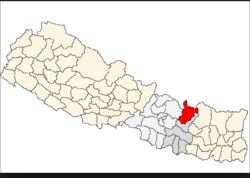
The village is situated in the lap of Mt. Gauri Shanker, a majestic Himalayan peak. The 6 hour drive from Kathmandu becomes pleasant all the way after the tourist resort of Dhulikhel. With a cup of tea at Zero one, the real journey begins. After Kharidhunga, there are valleys on the right as well as on the left of the road that runs along the ridge. Layers and layers of mountains and valleys, terraces and Himalayan peaks keep the journey pleasant. Once pristine, Charikot is now a bustling market place, often crowded. Then comes the historic Dolakha, a Newar settlement, after which one reaches Susmavati Village of Thamis, one of the earliest indigenous people known as Kiratis of Nepal.
 In my view, TRAS has made the right decision to support Shree Fashelung Social Service (SFSS) to rebuild the toilets. I visited many houses that are now reduced to rubble. There is not a single house in the village that did not suffer damage during the earthquake of April 2015. Except for some limited emergency relief of supplies like rice, corrugated sheets, clothes, and temporary learning centres for children by the government, NGOs like Plan International, individual donors, and the Nepal Red Cross, the entire 1540 households of the Susmavati Village area have not received any support for rebuilding. Almost into a year now since the disaster, all the households are living in makeshift shelters that have been created from salvaged materials. The makeshift toilets have been a serious concern to them. It was a very sad scene even now 10 months after the earthquake. It brought tears to my eyes.
In my view, TRAS has made the right decision to support Shree Fashelung Social Service (SFSS) to rebuild the toilets. I visited many houses that are now reduced to rubble. There is not a single house in the village that did not suffer damage during the earthquake of April 2015. Except for some limited emergency relief of supplies like rice, corrugated sheets, clothes, and temporary learning centres for children by the government, NGOs like Plan International, individual donors, and the Nepal Red Cross, the entire 1540 households of the Susmavati Village area have not received any support for rebuilding. Almost into a year now since the disaster, all the households are living in makeshift shelters that have been created from salvaged materials. The makeshift toilets have been a serious concern to them. It was a very sad scene even now 10 months after the earthquake. It brought tears to my eyes.
Every family in this area makes their living from limited land on the mountain slopes and some wages from labouring in nearby market centres like Dolakha Bazaar, Charikot and Kathmandu. Prior to the earthquake, the village was an Open Defecation Free and Indoor Smoke Free zone – this is by no means a small achievement.
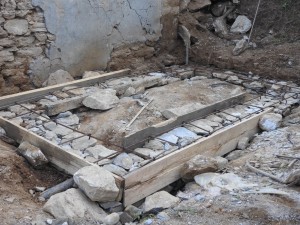 There is 24/7 electricity supply to the village from a micro-hydro unit that produces a little less than a kilowatt output just a kilometre down the stream – can be considered a luxury compared to Kathmandu with 16 hours of power cut every day. Almost all the households had high definition TV dish antennas. Every adult carries one cell phone. Before the earthquake, many households had permanent toilets with biogas plants that were used for cooking food. They looked comfortable with what they had. The Thami people are peaceful and content with what they have even now, although they have nothing except the few patches of land on the slopes of the mountains.
There is 24/7 electricity supply to the village from a micro-hydro unit that produces a little less than a kilowatt output just a kilometre down the stream – can be considered a luxury compared to Kathmandu with 16 hours of power cut every day. Almost all the households had high definition TV dish antennas. Every adult carries one cell phone. Before the earthquake, many households had permanent toilets with biogas plants that were used for cooking food. They looked comfortable with what they had. The Thami people are peaceful and content with what they have even now, although they have nothing except the few patches of land on the slopes of the mountains.
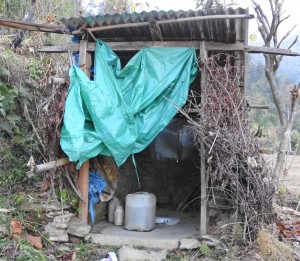 I spent an overnight in a thatch house on a slope on the roadside – courtesy of SFSS. The structure is standing on about 16 thin wooden poles with a diameter of five inches. I shared the room with the driver who drove me to this village. During the night, the driver told me that the thatch swayed whenever someone walked or if there was a gust of wind. At the back of our minds were the earthquakes that continued intermittently now and then. I did not want to think of that. The visit to the squat toilet at night was a nightmare because I had to navigate through unstable rocks some 30 feet down a slope.
I spent an overnight in a thatch house on a slope on the roadside – courtesy of SFSS. The structure is standing on about 16 thin wooden poles with a diameter of five inches. I shared the room with the driver who drove me to this village. During the night, the driver told me that the thatch swayed whenever someone walked or if there was a gust of wind. At the back of our minds were the earthquakes that continued intermittently now and then. I did not want to think of that. The visit to the squat toilet at night was a nightmare because I had to navigate through unstable rocks some 30 feet down a slope.
SFSS has calculated how many households would need toilets. They found the following: Total households 1540. Households living in Kathmandu and elsewhere: 200, households which have financial capability: 100, households having joint toilets: 300. From these figures, they have come up with the figure of 940 households needing toilets. Of this total need, TRAS has been approached to fund 200 toilets at this point in time.
SFSS has selected a first batch of 40 households to receive toilets on the basis of following criteria:
a. Households with more than 3 people living 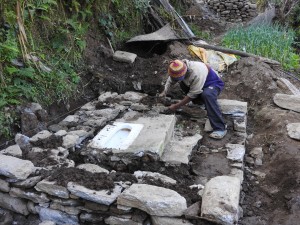
b. Lowest income
c. Permanent residency
d. Socially active
e. Total destruction of the former toilet by the earthquake
SFSS under Bhakta Singh Thami, a retired Police Constable, and his team impressed me by their work. All of them are working as volunteers. I met all of them. Every one of them lost their houses like everyone else in the village. They are diligently working to ensure that their village is rebuilt and have brought the village life style back to normal. They have let the villagers know the selection criteria and answered all questions from the community to ensure that there is no conflict.
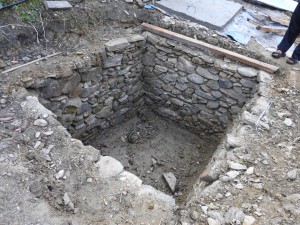 SFSS is satisfied with the work of the village masons carrying out the work. SFSS has procured the cement from Santosh Construction Materials Centre in Charikot, the nearest market to the village. Based upon my comments, SFSS has decided to increase the level of monitoring the construction work for quality control, and ensuring every toilet has a running water tap. Overall, the construction work is going on pretty well completing almost all 40 toilets. I inspected about 15 households and the toilets under construction in various stages from digging ground for septic tanks, raising walls, laying squat toilets, etc. As the households are scattered along the mountain slopes, even walking the trails was tricky in a few places requiring some assistance from the locals.
SFSS is satisfied with the work of the village masons carrying out the work. SFSS has procured the cement from Santosh Construction Materials Centre in Charikot, the nearest market to the village. Based upon my comments, SFSS has decided to increase the level of monitoring the construction work for quality control, and ensuring every toilet has a running water tap. Overall, the construction work is going on pretty well completing almost all 40 toilets. I inspected about 15 households and the toilets under construction in various stages from digging ground for septic tanks, raising walls, laying squat toilets, etc. As the households are scattered along the mountain slopes, even walking the trails was tricky in a few places requiring some assistance from the locals.
SFSS is already on the way to selecting the next batch of 40 households. They will need the funds right away. In view of the recent experience of the long delays in transferring funds, I recommend TRAS initiate sending the next disbursement of funds at the earliest. The villagers are mindful of the usual storms that normally arrive towards the end of March and beginning of April, followed by monsoon rains in June. SFSS is therefore keen to build the remaining toilets as soon as possible. I reminded the SFSS Committee to send an interim progress report to TRAS.
I noted there was only one woman on the SFSS committee. Upon my suggestion, SFSS has committed to increase women’s participation in committees, programs and activities in the coming days. They will initiate activities to help towards women’s health and children’s education, raising funds locally to cultivate the culture of giving especially during festivals and birthdays, preparing skills development programmes, supporting women’s cooperatives, etc. I see great potential for TRAS to help this community in health and education sectors. The need is there. The partner is genuine and good. They are fresh and willing to learn and they want to take responsibility.
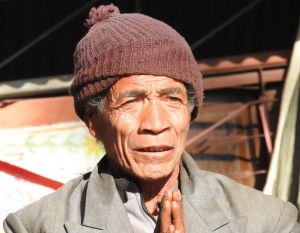 My visit to the project site was concluded with a community meeting in which 88 people participated to welcome TRAS’s visit, review and report about the toilet construction progress and provide individual feedback from the beneficiaries. It was a beautiful sunny morning, in the open air on the ground of the community school. I had the opportunity to listen to the pains and pangs from the villagers, both men and women, during and after the earthquake, the continued struggles and their hopes for the future. They asked me to give my impressions of their village and their work. I told them what I saw, how I felt and how I visualized their upcoming future. With jubilation, the meeting concluded. The SFSS committee members walked up to the road to bid farewell.
My visit to the project site was concluded with a community meeting in which 88 people participated to welcome TRAS’s visit, review and report about the toilet construction progress and provide individual feedback from the beneficiaries. It was a beautiful sunny morning, in the open air on the ground of the community school. I had the opportunity to listen to the pains and pangs from the villagers, both men and women, during and after the earthquake, the continued struggles and their hopes for the future. They asked me to give my impressions of their village and their work. I told them what I saw, how I felt and how I visualized their upcoming future. With jubilation, the meeting concluded. The SFSS committee members walked up to the road to bid farewell.
Sewa – the Thami way of saying namaste!

